Table of Contents
Platy Overview
Platy (xiphophorus) is a very popular tropical freshwater fish species held by aquarists around the world. They are extremely beautiful, small fish and come in every single color imaginable. Part of their popularity is due to the very low experience needed to keep them. Males grow to about 1.5 inches and females, being a little bigger, can grow up to 2.5 inches. Platies are native to both Central America and North America. There are numerous types of platies, but all are hybrids of two species heavily interbred in order to reach their full potential. The two most common species are Southern platy (Xiphophorus maculatus) and Variatus platy (Xiphophorus variatus).
As most other species from the Poeciliidae family, platies are great fish for both beginners and experienced aquarists. They are easy to keep and breed and their potential is great.
| Information chart | Platy |
|---|---|
| Scientific name: | Xiphophorus maculatus |
| Family: | Poeciliidae |
| Care level: | Easy |
| Temperament: | Peaceful |
| Color: | Beige, brown, light orange, pale yellow, deep back, etc. |
| Lifespan: | 3 to 4 years |
| Size: | 7 cm (2.8 in) |
| Diet: | Omnivorous |
| Minimum tank size: | 10 to 12-gallon tank |
| Temperature: | 70-82°f |
| Water Conditions: | Mostly alkaline water but can survive in other water conditions as well. |
| Tank mate compatibility | Guppies, mollies, and some types of tetras |
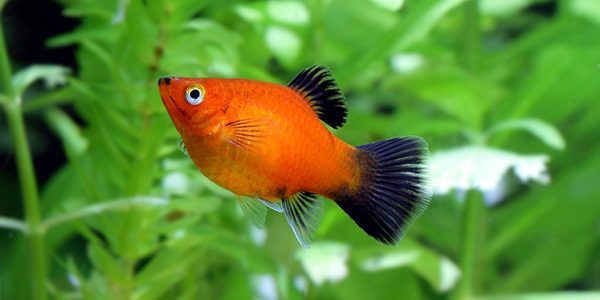
Platy Appearance
This small, beautiful fish comes in various beautiful colors ranging from beige, pale yellow, brown to muted orange and deep black. They come in four varieties of red – blood red, brick red, coral red, and velvet red.
They often get confused with a molly for having similar features. The pointed heads and fanned-out midsections give them the illusion of a diamond-shaped body. The platyfish do not have the distinct lateral line common among the Xiphophorus species.
Types of Platy Fish
Comet Platy
Orange and yellow are the most common types of Comet Platy fish. They have striped tails, and the caudal fin has black outlines on either margin.
Gold red platy fish
The color ascends from yellow in the front to a deep red at the back. This gives the Gold Red Platy fish a beautiful sunset gradient. It has black and translucent tails.
Hifin Platy Fish
The Hifin Platy fish has an elongated dorsal fin. Countless colors and patterns are available. However, elongated fins can often lead to serious diseases for the fish.
Mickey Mouse Platy Fish
This fish has a mark of a mickey-mouse shape on its tail. They come in a lot of colors but are pretty rare.
Pintail Platy Fish
This is not as common as the Hifin Platy fish. They have a pointed tail like a pin. The center of the pin is spread out with a pointy end.
Rainbow Platy Fish
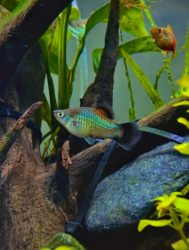
These fishes have an iridescent hue like a rainbow and have a black tail. Colors can range from light to darker shades.
Salt And Pepper Platy Fish
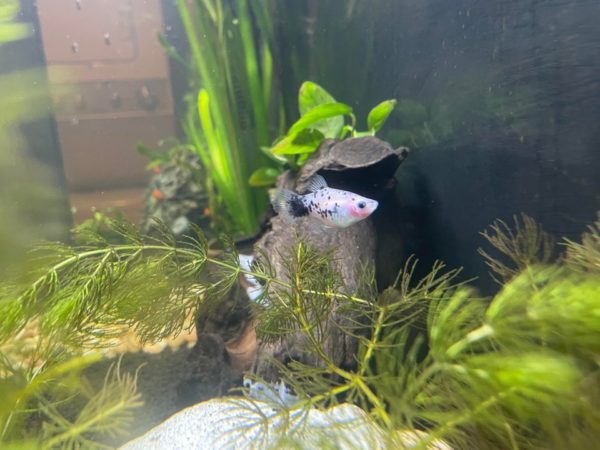
Tiny black spots like pepper are scattered all over the body of this fish. The color of the pattern is always black. However, the basic color on the fish’s body can vary from lighter to darker shades.
Tuxedo Platy Fish
The posterior portion of this fish is black, making it look like it is wearing a tuxedo. The combination of black and red is the most common, but other variations are also available.
Platy Fish Lifespan
Platy fish can live up to 2 to 3 years in an aquarium tank. It is crucial to keep the fish in an exceptional environment that can mimic their natural habitat. Stress-free conditions, clean water, and the required nutrition are vital to thriving.
Platies are hardy fishes. They can survive in a lot of different water conditions. Make sure to use a proper filter and keep them in slightly alkaline water to ensure a longer lifespan.
Platy Fish Size
The maximum length of a Platy is about 7 cm (2 in). The females can grow up to 3 inches as they are longer than the males. The southern Platy fish is a little bit larger than the other variables.
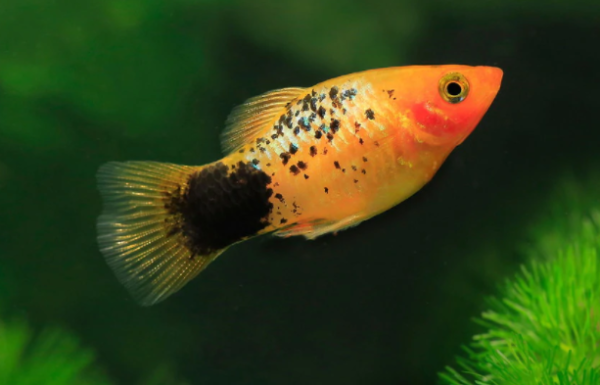
These fishes take about four months to grow to a full size. Adults in a community tank can often eat baby platies before four months. Hence, it is better to keep them separate for four months.
Platy Fish Natural Habitat and Origin
Platies are native to both central America and north America. They are also abundant along the east coast of southern Mexico. These freshwater fishes are of two species – Xiphophorus maculatus and Xiphophorus variatus.
They are usually crossbred with each other or sometimes with other swordtail fishes. The Platies that we buy as pets are more colorful than the wild ones. Both the species are abundantly available in the wild and the pet trade.
Platy Fish Care and Tank Setup
Platy Fish Tank Size and Specification
Optimum Tank Size for Platy Fish
Although platies are very small, they are an extremely active species. They love being in groups, but they are not a schooling fish.
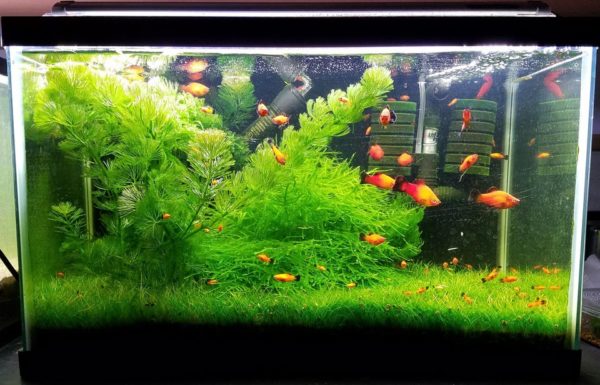
Having more than five fish in a ten-gallon tank is not recommended. There should be plenty of open space for the fish to swim and release energy. When it comes to the male and female ratio, the best thing you can do is keep a group with one male and at least three females. This will help in reducing the stress females are often exposed to.
Tank Shape for Platy Fish
A rectangular tank shape is best for platyfish. In a rectangular tank, the water surface area is larger than the volume of water. This is crucial for the exchange of gasses with air. Securing the tank with a lid is a must as platies can often jump out of the tank.
Platy fishes are ideal for community tanks. Many fishes will need a healthy exchange ratio between gasses and air for their survival. Hence, a rectangular tank is the most suitable option for a platyfish.
Filter Type
Proper filtration is essential for the setup of a platyfish tank. Filtration helps keep the water clean and reduces ammonia and nitrate levels in the water.
If you want your platies to thrive, you should definitely pay attention to water filtration. The filtering system should be able to keep the water in great condition and get rid of waste or excess food that will harm the water quality. Experts point out that great water conditions are particularly important for Swordtail platies, as they are more vulnerable to poor water conditions than other variations.
Filters that produce strong currents are not good for these fishes. They prefer slow-moving water. Platies do not make a lot of waste, but a proper filtration system will help clear toxins from the water.
Substrate
Platies do not swim at the bottom of the tank. They are not really picky about the substrate. A dark-colored substrate helps to enhance the vibrant colors of the fish.
Gravel and sand are good options as a substrate for a platy fish tank. You can also leave it bare at the bottom to give a clean look to your aquarium.
How Many Platy Fish in A Gallon Tank?
A ten-gallon aquarium should be just enough for a group of 5 adult platies. They are peaceful fishes, and it is absolutely safe to keep more than one in a tank.
Water Conditions
Water Temperature
Platies prefer water temperatures in the range of 70-77⁰ Fahrenheit. They are tolerant to temperature and water fluctuations but take care of sudden water parameters changes. These types of changes can lead to stress and should be avoided.
Water Flow Rate
The water flow should be slow as platies are accustomed to slow-moving water. They are not very large. A high current in the water will make it difficult for them to move.
Ph Level
Platies are tolerant to a wide range of water conditions. As for the water pH, platies thrive in slightly alkaline water, ideally ranging from 6.8 to 8.0.
Water Hardness
The water hardness should be anywhere between 10–28 dgh.
Platy Tank Landscape
Best Plants for Platy Fish Tank
Plants inside a tank will act as hiding spots for platies and make them feel at home. Hardy plants like hornwort, duckweed, and java moss are suitable. These will survive the alkaline water conditions inside the tank.
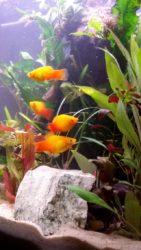
Floating plants are also a great option as they often swim on the surface. Platies do not eat live plants inside the tank. However, they can sometimes nip at hair algae.
Decorations For Platy Fish Tank
Natural decorative items like driftwood or rocks are suitable for a Platy Fish tank. They are great at recreating the ambiance of their natural habitat. Planted tanks are a bonus!
Platies swim a lot and love to play inside the tank. Hiding corners or plants that can serve as shelters are great for them.
Lighting For Platy Fish Tank
It is best to avoid harsh lighting inside a platyfish tank. Moderate lighting is best during the day. Dim lights at night will mimic their day-to-night cycle in a natural habitat.
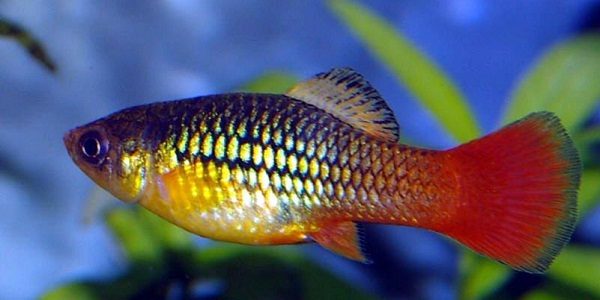
Feeding Platy Fish
Best Diet for Platy Fish
Platies are considered omnivorous, but they have a substantial need for herbivorous food. A diet rich in vitamins improves the colors of a Platy fish. One common mistake aquarists make is not adding enough algae or other vegetation for the platies. An ideal diet should be a healthy mix of both proteins and vegetables. Flakes and other prepared fish food are great for them as long as they are high in protein. Spinach, cucumber, and lettuce are some vegetables that you can give to a Platy fish.
As far as live food is considered, they enjoy bloodworms, daphnia, brine shrimp, mosquito larvae, or fruit flies. If you can’t afford live food or it is not readily available, equivalent frozen foods should be just as good for your platies.
How Often Should You Feed Platy Fish?
Serve portions of food that a Platy fish can finish within three minutes. Feed your young platies several times daily. Adult ones should have two meals every day.
Platy Fish Behavior and Temperament
Platy is not an aggressive fish. They are social, peaceful fishes that are suitable for community tanks. Swimming in groups of six, they will make any aquarium look stunning and colorful.
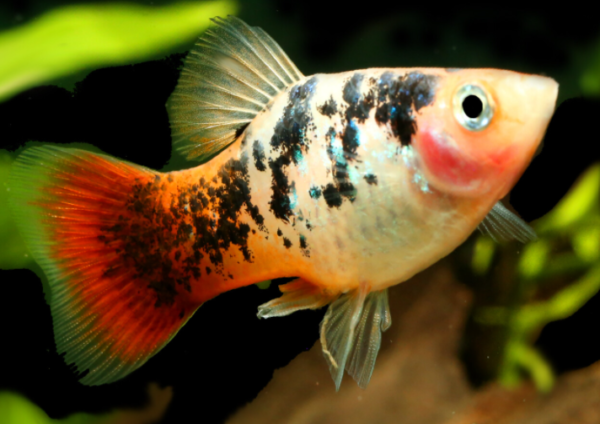
These are active fishes who like to play and swim mostly in the upper levels of the tank. They will hide in shelters and explore every tiny detail inside the tank. They will adapt to various water conditions and become friends with other species inside the tank.
Platies can only show aggression during times of breeding. The males keep pestering the females and become a little irritated. Putting more females in the tank will ensure that the males do not disturb them. They stay active during the day and rest at night.
Are Platies Lonely or Societal in Nature?
Platies are very peaceful and social fishes. They rarely get aggressive, which makes them suitable pets for community tanks. They get along really well with other Xiphophorus fishes like Guppy and Molly.
Platy Tank mates
In general, platies are peaceful and active. They are by no means aggressive, so they should be great tank mates with other species. Fights between platy males happen from time to time, but the risk of injury isn’t very high in most cases. Platies are most commonly kept in community aquariums with other small size fish and close relatives. They get along very well with guppies, mollies, and some types of tetras. Some corydoras and characins in general are also great tank mates for platies.
Ideal Platy Fish Tank Mates
The best tank mates for a Platy fish are
- Corydoras
- Characins
- Molly
- Guppy
- Small tetras
- Rasboras
- Snails
- Rainbowfish
Bad Tank Mates for Platy Fish
Avoid keeping long-finned Platies with fin-nippers like tiger barbs and tetras. Aggressive fishes like bettas should not share a tank with Platy fishes.
Breeding Platy Fish
Platies are live-bearing fish, like most of their close tropical freshwater relatives.A convenient factor for beginners is the platies ability to breed without a lot attention from the aquarist. They will breed very often and with a lot of fry. As experienced aquarists like to say, “Getting platies to breed isn’t difficult. Stopping them from breeding definitely is.” Given their ability to breed very fast and very efficiently, you can find yourself with more platies than you need in no time.If you care for them properly, the only thing you should worry about is overpopulation.
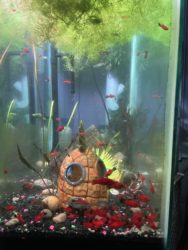
The pregnant female platy can produce broods monthly. It is easily identified with a huge belly and a dark gravid spot near the anal fin. These fishes can easily breed in a well-planted community tank with thick vegetation and a breeding trap for the fry.
A 10 to 20- gallon tank with stable water conditions, dense planting, and a regular filter are suitable for the fish to produce fry. Gestation usually takes somewhere between 4 to 6 weeks.
Once the fry are born they will freely swim around in search for food; however, the potential aggressor of the fry (even parents are known to eat them) should be removed from the tank. Planted tanks can only protect the fry for so long before they are eaten. While plants may help in the short term, removing one of the two is definitely a superior solution.
Breeding Level
Easy
Sexual Dimorphism
Sexual dimorphism is less in Platy fishes. The male’s caudal fin is a little more pointed, and the anal fin has a tick-shaped organ used for reproduction. Females grow about an inch taller than males.
Common Diseases and Their Treatment
Platy is a hardy fish that is not susceptible to many diseases. However, there are a few common freshwater diseases that can affect them.
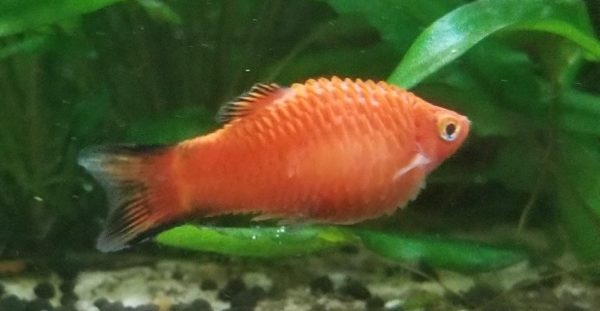
Fin Rot
Stress and poor-quality water conditions can result in his disease. Fin rot can affect long-finned platy fishes like hifin platy and pintail platy. The fins become tattered and ragged and start changing color.
Fin Rot starts at the base of the fin and keeps destroying the tissues further. Soon it can spread all over the fish’s body and rot it.
Frequent water changes and regular antibiotics can prevent the disease. Remove food debris from the bottom of the tank and avoid overfeeding the fish.
Ich
The major symptom of ich is when the fish develops white spots all over the body, fins, and gills. Platies infected with ich can become lethargic and aggressive.
Immediately separate the infected fish in a different tank with increased temperature (at least 2 to 3 degrees). Adding a tablespoon of salt for every 5 gallons of water is adequate to get rid of the parasites.
Velvet
This disease causes yellow to rust-colored cysts in the fish’s skin and gills. Other symptoms include mucous secretion, clamped fins, labored breathing, lethargy, and flashing.
Quarantine the fish and keep the lighting dim. Raise the temperature and add aquarium salt and copper sulfate for ten days. Make sure to discontinue any carbon filtration during the treatment period.
Swim Bladder Disease
The swim bladder is responsible for controlling the buoyancy of a fish. Any dysfunctionality in this gas-filled organ can make swimming difficult for platies. High ammonia content in the water and stress can be two significant factors behind this disease.
Symptoms include difficulty in swimming, improper balancing, floating at angles or upside down, and a swollen belly.
Figuring out the reason behind the stress of your fish is the initial step for the treatment of the disease. Keep changing the quality of the water frequently to keep it clean and healthy.
Camallanus (Internal Parasite)
Camallanus is a parasite that can affect the health of your Platies severely. As a symptom, one may find a brown-colored worm sticking out of the anus of the fish.
It is important to vacuum the substrate and clean the filter to treat the disease. Maintain a strict 5-day treatment with Levamisole. Repeat the entire process after three weeks.
Dropsy
This bacterial infection affects the kidney and liver of your platyfish and makes them retain water. Symptoms include a swollen belly, porked-out scales, and unusual swimming patterns.
This disease is incurable once it attacks the kidney or liver of the fish. Adding two tablespoons of Epsom salt for every gallon of water will help your fish relax a bit.
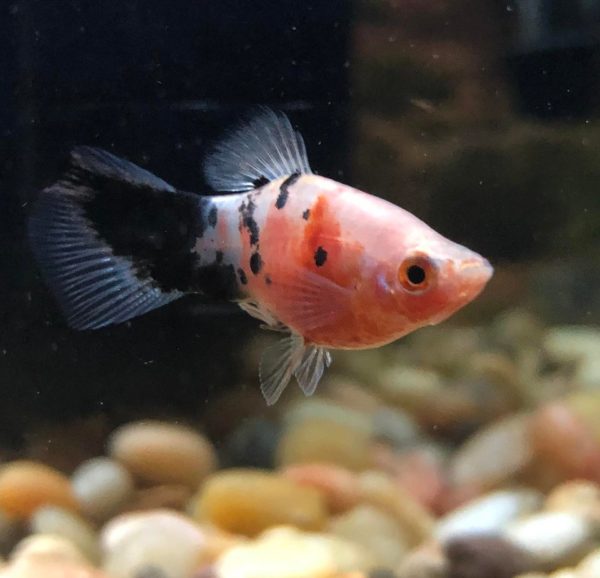
Facts About Platy Fish
- Numerous colors and variations are available among the Platy fishes like Coral Red, Red and Black Tuxedo, Red Wagtail, Salt, Pepper, etc.
- Platies are well-tempered fishes that can stay with many other tank mates in a community tank.
- These omnivorous fishes are not at all picky about their food. They eat all types of the packet and domestic fish meals.
- Females are about an inch longer and plumper than males.
- Platy fish is a live-bearing fish. They fertilize the eggs inside their body and release them after hatching.
- It is not difficult to make them breed. It is difficult to make them stop.
- The males can badger the females for reproductive purposes. It is important to maintain male to female ratio. One male platy is enough with two to three female platys.
- Platies can end up eating their babies, thinking them to be food.
- They have a short lifespan of two to three years.
- As active fish, they like to swim and play a lot. Planted aquariums are the best option for them as they provide a lot of hiding shelters.
- Due to their peaceful nature, they are compatible with endless fishes like guppies, mollies, swordtails, etc.
- Once the juvenile platies survive the first four months, they are pretty easy to raise.
- These fishes should at least be kept in an aquarium of about 10 gallons to swim freely inside the tank.
FAQs
Do Platies Eat Their Babies?
Yes, platy fishes eat their babies. Adult platies have very poor parental instincts. They can often end up eating their babies as food.
How Many Platies Can I Put in A 10-Gallon Tank?
A 10-gallon tank can be home for up to 5 platy fishes.
Can Platies and Mollies Live Together?
Yes, platies and mollies can live together. Platies are quite peaceful and are compatible with a lot of other fishes. It can live with other Xiphophorus fishes harmoniously.
How Long Do Platy Fish Live For?
Platies live for about 2 to 3 years. They do not have a very long lifespan. Better water conditions and regular cleaning of the tank can help your platies live a little longer than average.
Conclusion
Platies are easy to keep as pet fish for beginners. They are peaceful and are very easy to look after. Hardy fishes like platies can survive in minimum tank requirements and various water conditions. Feeding them is very convenient as they are not picky eaters.
Once you manage to separate the fry from the adults for about four months, you will have a lot of juvenile platies to keep in your tank as well.
Their playful nature is fascinating to watch as they actively swim through the tank throughout the day. It never gets boring!
If you are beginning your journey with pet fishes, platies are one of the easiest fishes to start with. Get your hand on a variety of colors and enjoy watching them dart around your fish tank.
No related posts.

15 thoughts on “Platy – Complete Guide to Care, Breeding, Tank Size, and Disease”
What of I have gold fish flakes and beta pellets which would they like better? Also are they bottom feeders at all they don’t seem to be and I haven’t tried any live or fresh food nor plants but was told to feed them 3 times a day until they have fully matured but they leave a lot of food fall to and just sit at the bottom of the tank and do they just let it sit and do they like light also do they have to have a filter to live
They don’t eat off of the ground. And they do need filter to live. The filter helps them breathe. All freshwater fish need filters. I feed mine once a day so the water doesn’t get dirty as quick. (Fish always act like they are starving regardless of the situation) and the light is fine. And you can get Tropical flake food for the platies. Hope this helps!
They will eat off of the ground depending on the food. My platies are ravenous and constantly scour the gravel for food even after being fed fish flake or frozen/live food. They love to eat the algae wafers I feed to my pleco, otos and shrimp and they constantly graze off of decaying plant matter in any part of the aquarium. I recommend feeding them algae wafers, the wafers are good for them and they love it.
They even eat the sinking Hikari crustacean pellets I feed my shrimp. Be careful of overfeeding though. All fish are prone to gorging themselves on whatever food is given because in the wild they will never know when their next meal may be.
And I agree with Shianne about the rest of her post. They absolutely need a filter, a really good filter at that, because they produce so much waste.
I have 3 platies and some goldfish all of them tend to eat off the ground sometimes on the bottom I have rocks and gravel and some plantS I also have pleco they all get along great no fights.
They will happily scavenge foot off the bottom of the tank, if they don’t you are definitely over feeding …
flakes are suggested dont do live food be careful about the food on the bottom you dont want an ammonia spike try reducing the quantity of food you give and definitely get a filter there are a lot of good deals out there
I agree with platy man my platies eat off the ground too.
How do you tell male or female with platies
The bottom fin on a Male typically is more tucked to the body and sharper in shape while the females bottom fin is more fanned out and rounded.
Me and my partner have just got two platies and I was just wondering what to look out for once we have put them in the tank. It’s there second day in their new tank. We have one orange one which is just swimming around the bottom of the tank. Then we have a black one which was hiding in the cave, but he now is swimming up at the top of the surface. Should we be concerned?? We have two shrimp with them and will be getting some minnows to go in as well
Platys like steady moving water, not fast moving waters…
Just keep an eye out for common problems like ICH. Also ensure you have good filtration and circulation, the shrimps should help keep the waste from the fish low but clean good water is a must. get a 5in1 test kit and ammonia test just to keep track of keeping them healthy.
If they are both male they may want to keep their distance hence why one will hide at times, they’re not exactly territorial but with there only being 2 they won’t school together.
Ensure they’re eating, they’re mostly herbivores but do need protein in their diet. If one is male and the other female you may want to add a couple more females as males can get relentless in their pursuit for breeding, usually having about 3 females to 1 male is a good ratio as so females can have a break!
If you’re not wanting to breed having about 5 or 6 depending on your tank size is usually a good number as they are quite happy to be in groups.
why do platys skool on the surface?? i just purchased a 45 g tank and they are skooling in the surface. i have other tanked and they are not in those tanks. i started with 5 i now have over 50.
Do a 5in1 test on the water and as importantly check ammonia levels. Keep on top of changing about 20% of your tank water every two weeks.
Platys though really easy to keep, they are quite sensitive to poor water, especially the sword tails so they maybe at the surface to avoid ammonia, I’m going to guess you have one large filter at one end of your 45 gallon tank (170 litres?) You may want to add an airpump at the other side to promote water movement (You don’t exactly need an over the top one, just one to add a bit of a circulation boost)
What filter/pump do you have?
And yea Platy breed like wildfire, If you are not wanting to breed them remove one of the sexes and put in a separate tank. Females can be identified as having a triangular anal fin (under the fish) where as the males have a thin pointed anal fin.
My platy gave birth to 52 frys. Is there a big chance that all of them will survive until they mature? Considering good aquarium set-up etc?
I have a rainbow shark.
Will Platys get bullied by this?